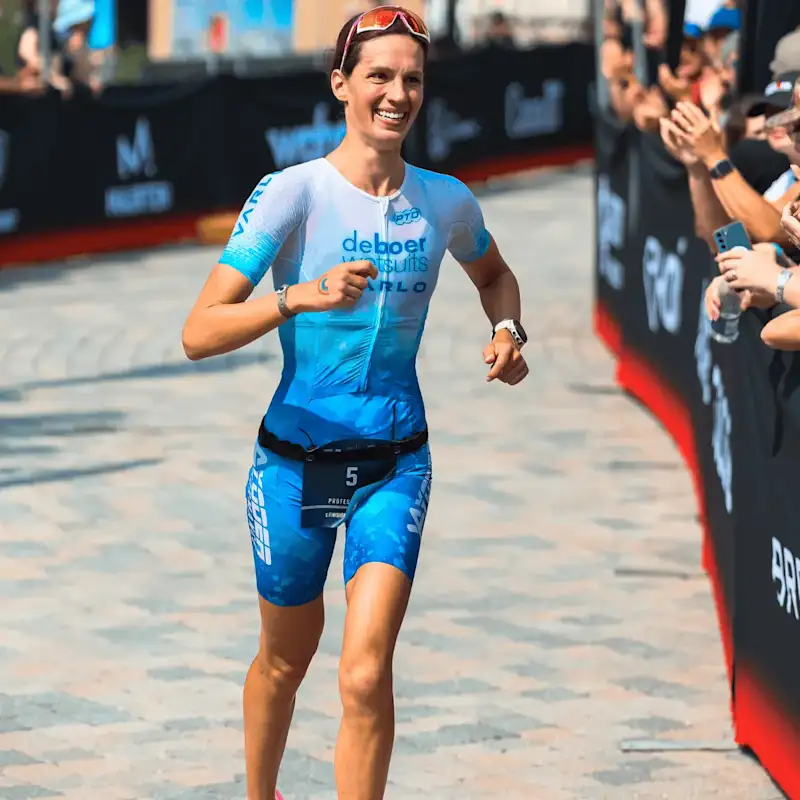
Rachel Zilinskas
IRONMAN® Arizona
Rachel's headline numbers
Rachel's strategy
Fueling
Carbohydrate is the main fuel you burn when racing. Failing to fuel properly is a leading cause of underperformance in longer races.
After a year of stop-start racing due to a nasty bike crash early in the season, Rachel’s first IRONMAN® back did not disappoint. With a revised fuel and hydration plan to ensure she had enough energy for both the bike and run, she felt strong throughout the race.
Previously, she's relied on a mix of gels and chews, alongside PF Carb & Electrolyte Drink Mix in her bottles, plus an additional ‘hydration-only’ bottle with concentrated electrolytes. But in Arizona, taking a slightly less common approach nowadays, she decided to re-coupled her fuel and electrolytes.
To hit ~103g/h on the bike, Rachel carried two dedicated “fuel” bottles, one 1-litre and one 750ml bottle, each containing a blend of PF Carb & Electrolyte Drink Mix and PF 300 Flow Gel. She supplemented these with a couple of PF 30 Caffeine Gels. On the run, she maintained a similar intake strategy, targeting ~102g/h by taking one PF 30 Gel every ~20 minutes, including a PF 30 Caffeine Gel at the halfway point. This strategy is in line with the scientific recommendations, and ensures blood glucose concentrations remain stable, limiting any peaks and troughs that would negatively affect energy levels.
Hydration
Taking on board an appropriate amount of fluid and sodium is essential to maintaining blood volume and supporting the cardiovascular effort needed to perform on race day.
Whilst the absolute amount of sodium and fluid consumed per hour is important, it’s critical to consider these in relation to each other. This is known as 'relative sodium concentration' and it’s expressed in milligrams per litre (mg/L). How much sodium you’re taking in per litre of fluid is more important than the absolute amount taken in per hour.
Sweat sodium concentration (mg/L) is largely genetically determined and remains relatively stable. Knowing how salty your sweat is enables you to replace a good proportion of your sweat losses, which can range from 200-2,000mg/L.
Whilst Rachel’s losses are on the moderate side, getting her hydration strategy right is still crucial when it’s hot and/or humid as her higher sweat rate in these conditions can result in significant net losses over the duration of a race.
Learn moreSimilar to her dialed fuel strategy, after recently having a Sweat Test, Rachel’s fluid and electrolyte intake was well suited to the conditions on the day and her known sweat losses. With a sweat sodium concentration of 901mg/L similar to that of the average we see across our database, Rachel used PF Carb & Electrolyte Drink Mix on the bike and Electrolyte Capsules on the run to ensure she replaced enough of her losses (at a concentration close to ~1,000mg/L) to avoid any dehydration-related symptoms. She reported feeling well-hydrated throughout, but may have benefited from increasing her fluid intake slightly, given the moderate temperatures on race day. For example, Rachel could’ve picked up an additional bottle from the aid stations. In future races, especially next year in Kona, Rachel will need to train her gut to tolerate far higher volumes of fluid to ensure she doesn’t lose more than 2% of her body mass, the threshold for dehydration where performance begins to suffer.
Caffeine
Beyond the Three Levers of Performance (carb, sodium and fluid), caffeine is one of only a few substances that is proven to improve performance for most endurance athletes as it can help stave off mental and physical fatigue.
Rachel’s caffeine intake was slightly higher than the general recommendations, using a total of four PF 30 Caffeine Gels on the day; one just before the race, two on the bike and one final dose on the run. The additional cola she picked up on the run would have increased this slightly too, but since she had no adverse symptoms on the day, it’s likely this was suitable for her and supported her energy levels well.
How Rachel hit her numbers
Here's everything that Rachel ate and drank on the day...
Rachel's weapons of choice
Final thoughts
Rachel's full stats
Data Confidence?
There is an adequate level of accuracy in the data collected and the numbers reported. The athlete manages to recall what they ate and drank including most specifics (brands flavours quantities plausible estimations of volumes). However there are estimations made within the data which affect the overall confidence level in the data reported.